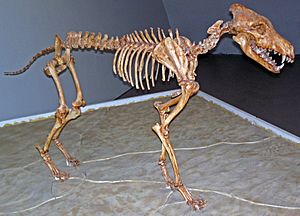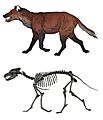Dire wolf facts for kids
Quick facts for kids Dire wolfTemporal range: Late Pleistocene – early Holocene (125,000–9,000 years ago)
|
|
|---|---|
 |
|
| Mounted skeleton, Sternberg Museum of Natural History | |
| Scientific classification | |
| Genus: |
Canis
|
| Species: |
dirus
|
| Subspecies | |
|
|
| Synonyms | |
The dire wolf (Canis dirus, meaning "fearsome dog") was an extinct type of wolf. It belonged to the Canis family, which also includes modern wolves and dogs. This animal is one of the most famous prehistoric carnivores (meat-eaters) that lived in North America.
Dire wolves lived in the Americas during a time called the Late Pleistocene and Early Holocene epochs. This was about 125,000 to 9,440 years ago. Scientists first named the species in 1858, a few years after its bones were discovered.
Contents
What Was the Dire Wolf Like?
The dire wolf was about the same size as the largest gray wolves we see today. It was a powerful hunter.
Dire Wolf Subspecies
Scientists recognize two main types, or subspecies, of the dire wolf. These are called Canis dirus guildayi and Canis dirus dirus. It is thought that the dire wolf probably developed from another ancient wolf called Armbruster's wolf (Canis armbrusteri) in North America.
What Did Dire Wolves Eat?
The dire wolf was a carnivore, meaning it ate meat. It likely hunted large animals that lived during its time. These included horses, giant ground sloths, mastodons, ancient bison, and camels.
Hunting in Packs
Like modern wolves, the dire wolf was probably a pack hunter. This means that many dire wolves would work together to hunt for their prey. Hunting in groups made it easier to take down big and powerful animals.
Why Did Dire Wolves Disappear?
The dire wolf became extinct during a time known as the Quaternary extinction event. This was a period when many large animals disappeared from Earth. Scientists believe that changes in climate and the loss of their main food sources played a big role in their extinction.
- For younger readers, you can learn more in the book: Dire Wolf by Marc Zabludoff, Marshall Cavendish, 2009.
Images for kids
-
Display at the Page Museum of 404 dire wolf skulls found in the La Brea Tar Pits
-
Restoration of a pack in Rancho La Brea by Charles R. Knight, 1922
-
Two dire wolves and a saber-toothed cat (Smilodon) with the carcass of a Columbian mammoth at the La Brea tar pits by R. Bruce Horsfall
See also
 In Spanish: Lobo gigante para niños
In Spanish: Lobo gigante para niños













